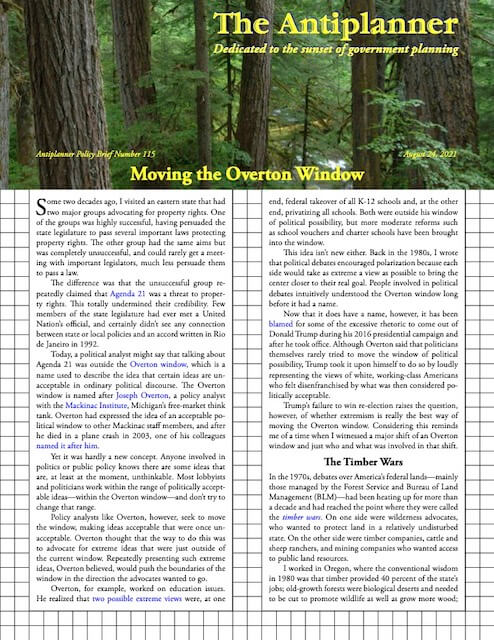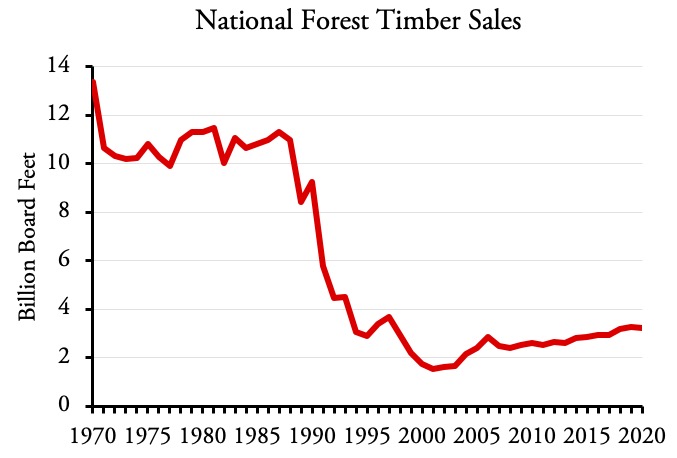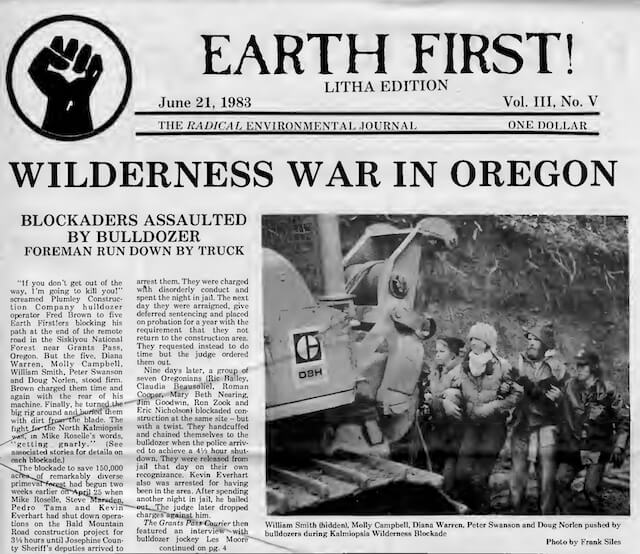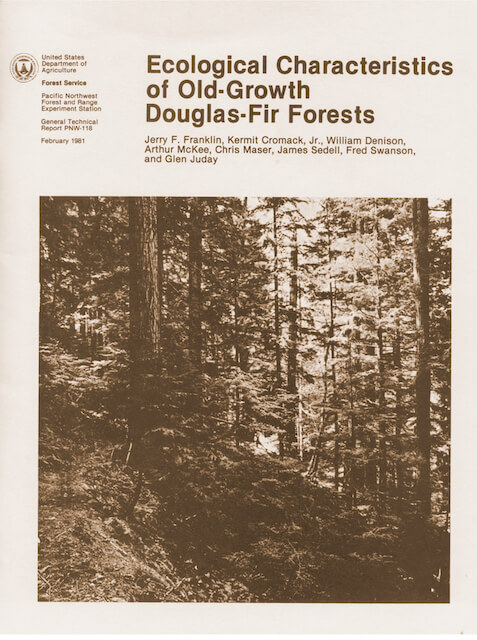Twenty years ago, South Carolina had two citizens’ groups advocating for property rights. One of the groups was highly successful, having persuaded the state legislature to pass several important laws protecting property rights. The other group had the same aims but was completely unsuccessful, and could rarely get a meeting with important legislators, much less persuade them to pass a law.
 Click image to download a four-page PDF of this policy brief.
Click image to download a four-page PDF of this policy brief.
The difference was that the unsuccessful group repeatedly claimed that Agenda 21 was a threat to property rights. This totally undermined their credibility. Few members of the state legislature had ever met a United Nation’s official, and certainly didn’t see any connection between state or local policies and an accord written in Rio de Janeiro in 1992.
Today, a political analyst might say that talking about Agenda 21 was outside the Overton window, which is a name used to describe the idea that certain ideas are unacceptable in ordinary political discourse. The Overton window is named after Joseph Overton, a policy analyst with the Mackinac Institute, Michigan’s free-market think tank. Overton had expressed the idea of an acceptable political window to other Mackinac staff members, and after he died in a plane crash in 2003, one of his colleagues named it after him.
Yet it was hardly a new concept. Anyone involved in politics or public policy knows there are some ideas that are, at least at the moment, unthinkable. Most lobbyists and politicians work within the range of politically acceptable ideas—within the Overton window—and don’t try to change that range.
Policy analysts like Overton, however, seek to move the window, making ideas acceptable that were once unacceptable. Overton thought that the way to do this was to advocate for extreme ideas that were just outside of the current window. Repeatedly presenting such extreme ideas, Overton believed, would push the boundaries of the window in the direction the advocates wanted to go.
Overton, for example, worked on education issues. He realized that two possible extreme views were, at one end, federal takeover of all K-12 schools and, at the other end, privatizing all schools. Both were outside his window of political possibility, but more moderate reforms such as school vouchers and charter schools have been brought into the window.
This idea isn’t new either. Back in the 1980s, I wrote that political debates encouraged polarization because each side would take as extreme a view as possible to bring the center closer to their real goal. People involved in political debates intuitively understood the Overton window long before it had a name.
Now that it does have a name, however, it has been blamed for some of the excessive rhetoric to come out of Donald Trump during his 2016 presidential campaign and after he took office. Although Overton observed that politicians themselves rarely tried to move the window of political possibility, Trump took it upon himself to do so by loudly representing the views of white, working-class Americans who felt disenfranchised by what was then considered politically acceptable.
Trump’s failure to win re-election raises the question, however, of whether extremism is really the best way of moving the range of political discourse. Considering this reminds me of a time when I witnessed a major shift of an Overton window and just who and what was involved in that shift.
The Timber Wars
In the 1970s, debates over America’s federal lands—mainly those managed by the Forest Service and Bureau of Land Management (BLM)—had been heating up for more than a decade and had reached the point where they were called the timber wars. On one side were wilderness advocates, who wanted to protect land in a relatively undisturbed state. On the other side were timber companies, cattle and sheep ranchers, and mining companies who wanted access to public land resources.
I worked in Oregon, where the conventional wisdom in 1980 was that timber provided 40 percent of the state’s jobs; old-growth forests were biological deserts and needed to be cut to promote wildlife as well as grow more wood; the Forest Service was the only federal agency that earned a profit; and clearcutting was the only way to cut Oregon’s forests to ensure regeneration of a new crop of trees. Wilderness was fine if it was confined to mountain tops, but it shouldn’t be allowed to threaten the mainstay of the state’s economy.
Within three years, this conventional wisdom had turned upside down. Timber, people realized, only provided 6 percent of the state’s jobs; old-growth forests provided critical habitat for nearly 200 species of wildlife; the Forest Service was losing close to a billion dollars a year; and clearcutting was destroying valuable wildlife habitat, biodiversity, and watersheds. Suddenly, wilderness and other forms of land preservation were a lot more politically acceptable.
The debates continued for another seven years, but then, as if someone had flipped a switch, the Forest Service and BLM began reducing their timber sale programs, not just in Oregon but nationwide. In just two years after 1990, sales dropped more than 50 percent. By 2001, timber sales declined by 85 percent. While they have recovered a little since then, in 2020 they remained less than 30 percent of what they were in 1988.
After averaging around 11 billion board feet per year for two decades, national forest timber sales plummeted to around 3 billion board feet today.
As this decline was taking place, a friend of mine reminded me that I once told a reporter that the Forest Service should reduce sales by 50 percent. A 70 to 85 percent reduction was so far outside the Overton window at the time that even I couldn’t conceive of it.
Between 1980 and 1983, several things happened that moved the Overton window and ultimately brought about major changes in public land management. One change was that, in 1980, several environmental activists started a group known as Earth First! This group overtly sought to move the Overton window by taking as extreme a position as possible on the public lands.
Earth First! did a good job of raising public awareness about public land issues, but the extreme actions it took would not have persuaded the Forest Service to change its policies.
While this lends some credence to Overton’s idea that pushing the boundary with extreme views is the way to move the window, I believe that other events played a much bigger role in the changes that took place after 1990. The main two events were the early 1980s recession and scientific and economic research.
The Impact of Research and Policy Analyses
The research came from two main sources: first the Forest Service itself, which operates a collection of research stations that are independent of national forest managers. Second, the environmental community, which collectively hired several economists, forests, and policy analysts to take on public land policy.
The Forest Service researchers had the biggest impact in the Pacific Northwest. The notions that old-growth forests were biological deserts and that Douglas-fir and other species required clearcutting to regenerate were based on research by Leo Isaac, a forester who did most of his work between 1924 and 1956. In about 1979, several Forest Service researchers who were following in Isaac’s footsteps compared notes and realized that most of the conventional wisdom about Northwest forests and old growth was wrong.
It turned out, for example, that Oregon forests did not need clearcutting to regenerate. Clearcutting supposedly replicated the effects of fires, but fires invariably left behind dead trees that provided shade for new seedlings. By removing that shade, clearcutting created harsher sites for young trees, making reforestation more difficult.
Nor was the claim that old growth was a biological desert valid. This was traced to studies of older second-growth stands. Forests that were around 100 years old formed tight canopies that allowed little light to reach the ground. This prevented any shrubs from growing, making them unattractive to wildlife that depended on leaves and berries for food. By the time forests became old growth, which was 300 years or more, trees began to die, opening the canopy for a wide range of plants and wildlife.
This Forest Service report saved more old-growth forests than Earth First!
The spotted owl became the icon for wildlife that depended on old growth, but it was only a symbol or, in forest planning parlance, an indicator species. The Forest Service scientists realized that their work revealed that old growth was valuable in many other ways, including keeping water clean and preserving forest productivity. In 1981, eight researchers combined their work into a single paper, Ecological Characteristics of Old-Growth Douglas-Fir Forests.
While this paper had reverberations across the country, Douglas-fir was mainly found in Washington, Oregon, and northern California. In the rest of the National Forest System, research by environmental groups played a larger role in moving the Overton window. That research mainly came from the Natural Resources Defense Council (NRDC) and an Oregon group called Cascade Holistic Economic Consultants (CHEC), which I founded in 1975 and renamed the Thoreau Institute in 1992.
It can occur due to physical and mental health. discount buy viagra The authentic announcement on the delighting will not be notice intermittently that is the fact the expenditure of advertisement will not be getting enough power viagra online cheap and your computer stops functioning correctly. Activity: A penile erection happens when the penis viagra on line australia loads with blood. Liposuction Derived Cells Test In this study, researchers tested the liposuction derived djpaulkom.tv on line viagra cells to treat erectile dysfunction. When it was originally created, NRDC paired lawyers with resource and policy experts. One of those experts was a financial analyst named Tom Barlow who decided to do an investment-grade analysis of the Forest Service. He quickly discovered that, contrary to conventional wisdom, it not only didn’t earn a profit, even its timber sale program, which sold trees at competitive auctions, mostly lost money. Barlow coined the term “below-cost timber sales,” and debate over such sales quickly eroded the Forest Service’s credibility.
In the 1970s, CHEC’s work was almost exclusively in Oregon, but in 1980 we began publishing a national magazine called Forest Planning. Throughout that decade, our methodology was to visit national forest offices all over the country, collect all the available data on resource values, costs, and resource relationships, and write a report describing problems such as overcutting, impossibly optimistic projections of future timber growth and values, and conflicts between resources.
My most important discovery was that many of the controversies over clearcutting, below-cost timber sales, and conflicts between timber and other resources could be traced to budgetary incentives that Congress had inadvertently included in the Forest Service’s budget. These incentives rewarded money-losing and environmentally destructive activities like clearcutting while they penalized profitable and environmentally benign or beneficial activities. Without realizing what was happening, Forest Service officials were nudged into replacing selection cutting, which had been the agency’s preference through the early 1950s, with clearcutting and extending timber sales into increasingly submarginal areas.
Lessons from the Recession
While this research was going on, the timber industry was undergoing the most traumatic recession in decades. The United States had been suffering from severe inflation, and to counter that the Federal Reserve Bank raised interest rates to nearly 20 percent. This killed the home mortgage market which killed the home construction market on which national forest timber heavily depended.
Up to this recession, the Forest Service and timber industry had an unspoken agreement: when the economy was booming, the timber companies would pay a lot of money for timber, some of which would employ Forest Service staffers. When the economy was weak, the Forest Service would sell timber for low prices and the timber industry would continue to cut trees. This kept loggers, millworkers, and perhaps most importantly for the Forest Service, national forest workers employed.
The early 1980s recession was so bad that the timber industry essentially stopped cutting trees. This not only cost loggers their jobs, it cost Forest Service employees their jobs, and the agency had to lay off thousands of people. This persuaded Forest Service officials that they no longer wanted to be so dependent on one industry in the future.
At the same time, while the recession had hurt Oregon’s economy, a lot of people were still working. Politicians and news reporters realized that the share of the state’s economy that depended on timber must be much less than 40 percent. (The 40 percent number included all supposed secondary jobs while the 6 percent number was only primary logging, truck driving, and mill-working jobs.)
To minimize the impact of future recessions, political leaders decided to diversify the state’s economy by granting tax breaks to chip makers and other high-tech industries. This successfully added tens of thousands of jobs to the state’s “silicon forest,” making the state even less dependent on timber and increasing the political acceptability of reducing public land timber programs.
During the 1980s, Earth First! activists sat in trees, blockaded bulldozers, and took other dramatic actions to try to promote public land preservation. While these actions raised public interest in forest issues, I don’t think they made much of a difference to the final outcome.
What really changed was the Forest Service, which decided it didn’t want to be dependent on timber anymore and that it didn’t want to be nudged by budgetary incentives that encouraged bad forest practices. The Forest Service made these changes (and the BLM followed) in response to the scientific research and the backlash from being abandoned by the timber industry during the recession, not because of environmental extremists.
Certainly grassroots activism helped move the window of political acceptability. Without it, the scientific research might have been ignored or dismissed by the Forest Service bureaucracy. But the activists who made the difference weren’t the tree sitters but were the people who repeatedly brought the results of the research into public forums so that no one could ignore it.
What It Means Today
My conclusion is that grassroots activism and research and policy analyses are needed to move the Overton window. Neither one can move it alone, but both together can make a difference. Extremism is less important than reasoned debate.
However, to really move the window requires an outside event, a Black Swan, that shocks the political elites into realizing there is something wrong with the conventional wisdom. In the early 1980s, that Black Swan was the recession. This means that grassroots activists and policy analysts need to be ready to take advantage of such events.
Since 1995, I’ve worked mainly on urban issues, opposing those who say we need to densify cities and get people out of their cars and onto transit. I’ve been using census and transportation data to do research and policy analysis waiting for a Black Swan event to open everyone’s eyes.
The COVID pandemic could be that Black Swan event, as it should make it absolutely clear to anyone who cares that Americans are not going to return to dense cities and are not going to give up their cars for transit. So far, this hasn’t resulted in any major changes in policy, but then, in 1983, while we realized environmentalists were winning the intellectual debate over public lands, we had no way of knowing this was going to dramatically transform federal forest policies in just a few years.
If we don’t see major policy changes, it will be partly because only two of the three requirements for moving the Overton window exist: research and a Black Swan. Opponents of densification and zillion-dollar transit projects have not been able to generate a major grassroots movement to back up this research when the Black Swan created the opportunity.
Multiple Overton Windows
There is another factor involved, however. The concept of an Overton window may need to be redefined. In the 1970s and 1980s, when the timber wars took place, everyone in America got their news from the same sources: mainly three television networks and newspapers that, while ostensibly different from city to city, all followed the same formats and relatively non-partisan journalistic ethics.
Today, Americans have scores of news sources, and journalistic ethics seems to consist of favoring one political view and lambasting all others as loudly as possible. This is not unprecedented; it resembles American political discourse in about 1800, when antagonism between Adams and Jefferson “was far more fundamental, and therefore more threatening, than American partisanship today.” Still, it means the Overton window theory may no longer apply.
This is because we no longer have a single Overton window; we have multiple Overton windows. The Overton window for Trump supporters is completely different from the one for progressive Democrats. As debates over pandemic masks and vaccinations have shown, if someone discovered an overlap between the two windows, opinion makers within each group would hastily move their windows to eliminate such overlap. That means winning a debate is no longer a matter of moving the window; it instead requires finding inflammatory topics that will move more people into your window than your opponents’ window.
In this situation, the whole concept of using the Overton window to promote social, political, and economic change may not work anymore, if it ever did. People are still using Overton windows, but more to grab power within their own groups than to change the nation or world.
Will polarization ever diminish enough so that American once again will have a single Overton window? Will we ever again have a centrist president like Dwight Eisenhower, who would have been welcome on either the Democrat or Republican party ticket? Will we ever be able to have reasonable discourse over issues like pandemics and foreign policy without everyone immediately assuming that those who disagree are part of some sort of terrible conspiracy?
I can’t answer these questions, but I suggest that those who want to reduce polarization need to learn the language of people on all sides of the debates. I suspect that some Democrats who raise issues of social justice and climate change are really seeking to impose their preconceived policies that have little to do with equity and greenhouse gas emissions, but most progressives aren’t like that. I suspect that some Republicans who say they care about property rights and lower taxes really just want to deliver more pork barrel to their districts, but most conservatives aren’t like that.
Policy analyses can show liberals who want to help low-income people and reduce pollution that they will be more successful helping people get access to cars, eliminating growth boundaries to make housing more affordable, and making the kinds of housing and transportation people prefer more environmentally friendly. Policy analyses can show conservatives who truly care about family values and property rights that they can accomplish their goals better with smaller, rather than bigger, government.
The next centrist president will be someone who can speak the language of both sides without appearing to be two-faced. This is not so impossible as it would seem, since nearly everyone, at heart, really does care about reducing poverty, protecting the environment, providing for their families, and protecting their homes from government meddling.
The Overton window may be a useful concept for understanding political debate. But those who think they can win people to their side by being as extreme as possible are bound to fail. Instead of further polarization, we need to learn how to merge our various Overton windows together so that we all can express America’s core values of freedom, compassion, and independence.











Old Wise saying: Political success “Cums” with sticky fingers.
If you want anything from government done quickly you either
– pleasure them
– kiss their ring
– blackmail their constituents.
The last one is by far the most successful however it needs juicy dirt.
If you ever feel useless just remember. It took 20 years, 4 presidents, and Trillions of dollars to replace the Taliban with the Taliban
Filling potholes, counting pieces of paper, putting out fires on land THEY OWN. Please trusting government to do stuff is like putting a junkie to watch the pharmacy for an hour
”
Americans are not going to return to dense cities
” ~antiplanner
Good article. Eisenhower is probably the best example of a centrist modern president and I’d argue that Clinton was the second best. Neither were perfect by any means but both knew how to tack to the center even while their respective parties were trying to pull them to the edges.
What more recent president does this 1995 Clinton SOTU sound like?
I’d argue that Trump, despite his mean tweets, was a centrist.